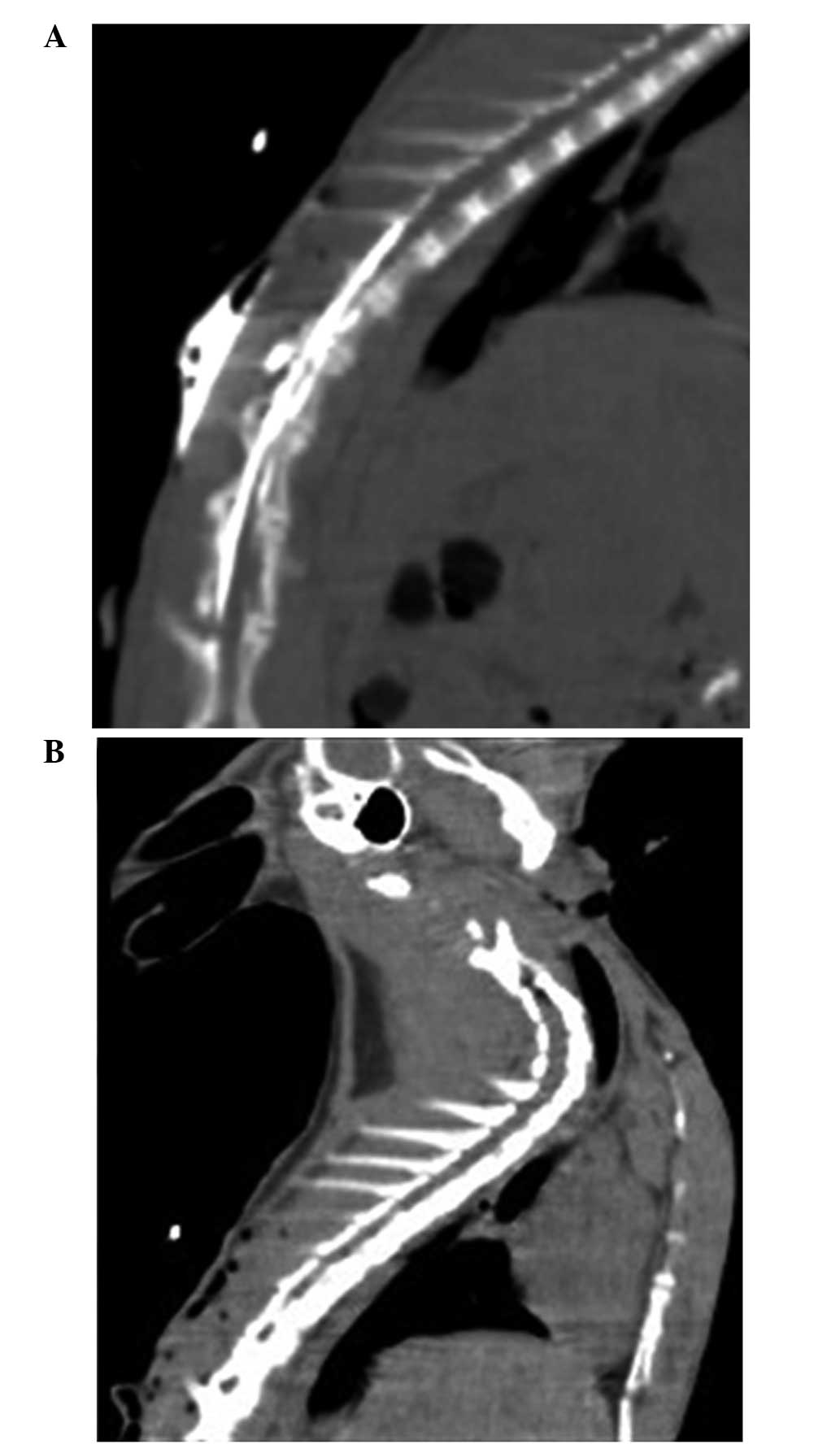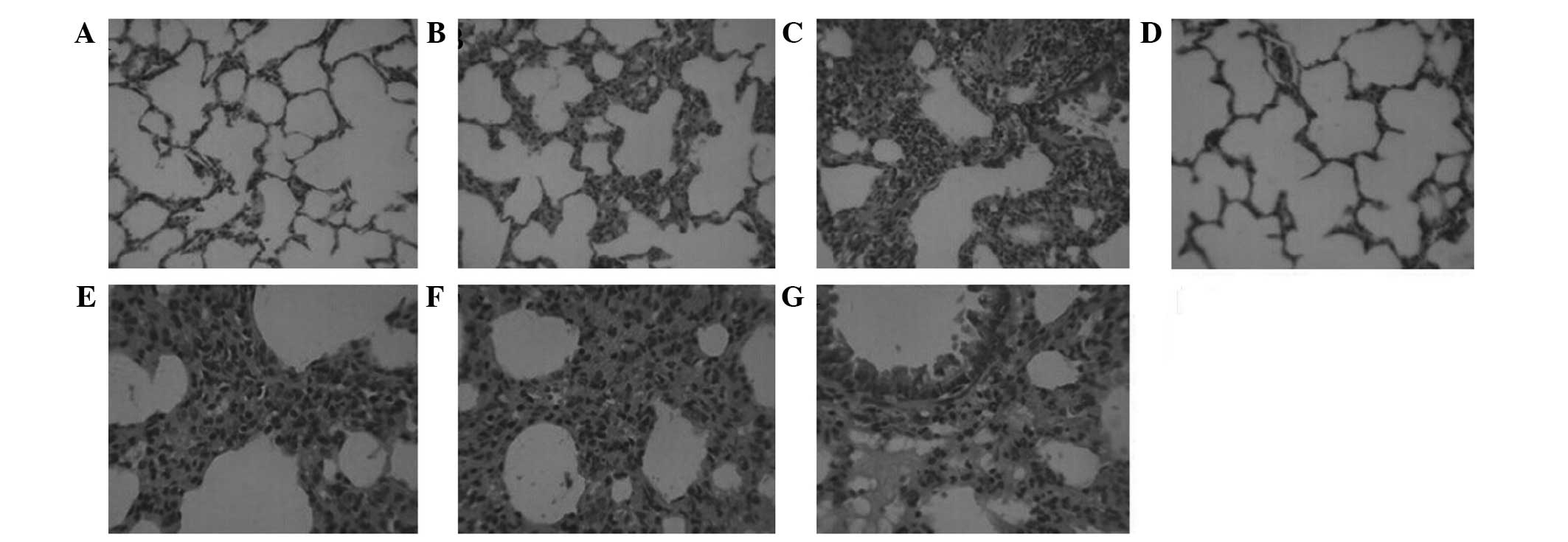|
1
|
Reiss LK, Uhlig U and Uhlig S: Models and
mechanisms of acute lung injury caused by direct insults. Eur J
Cell Biol. 91:590–601. 2012. View Article : Google Scholar : PubMed/NCBI
|
|
2
|
Rubenfeld GD, Caldwell E, Peabody E,
Weaver J, Martin DP, Neff M, Stern EJ and Hudson LD: Incidence and
outcomes of acute lung injury. N Engl J Med. 353:1685–1693. 2005.
View Article : Google Scholar : PubMed/NCBI
|
|
3
|
Jain S and Bellingan G: Basic science of
acute lung injury. Surgery. 25:112–116. 2007.
|
|
4
|
Rassler B, Marx G, Reissig C, Rohling MA,
Tannapfel A, Wenger RH and Zimmer HG: Time course of
hypoxia-induced lung injury in rats. Respir Physiol Neurobiol.
159:45–54. 2007. View Article : Google Scholar : PubMed/NCBI
|
|
5
|
Bhargava M and Wendt CH: Biomarkers in
acute lung injury. Transl Res. 159:205–217. 2012. View Article : Google Scholar : PubMed/NCBI
|
|
6
|
Cross LJ and Matthay MA: Biomarkers in
acute lung injury: Insights into the pathogenesis of acute lung
injury. Crit Care Clin. 27:355–377. 2011. View Article : Google Scholar : PubMed/NCBI
|
|
7
|
Dombrowsky H, Barrenschee M, Kunze M and
Uhlig S: Conserved responses to trichostatin A in rodent lungs
exposed to endotoxin or stretch. Pulm Pharmacol Ther. 22:593–602.
2009. View Article : Google Scholar : PubMed/NCBI
|
|
8
|
Calfee CS, Eisner MD, Ware LB, Thompson
BT, Parsons PE, Wheeler AP, Korpak A and Matthay MA: Acute
Respiratory Distress Syndrome Network, National Heart, Lung, and
Blood Institute: Trauma-associated lung injury differs clinically
and biologically from acute lung injury due to other clinical
disorders. Crit Care Med. 35:2243–2250. 2007. View Article : Google Scholar : PubMed/NCBI
|
|
9
|
Reyal Y and Bellingan G: The basic science
of acute lung injury. Surgery. 22:iii–vii. 2004.
|
|
10
|
Schwarzkopf K, Schreiber T, Bauer R,
Schubert H, Preussler NP, Gaser E, Klein U and Karzai W: The
effects of increasing concentrations of isoflurane and desflurane
on pulmonary perfusion and systemic oxygenation during one-lung
ventilation in pigs. Anesth Analg. 93:1434–1438. 2001. View Article : Google Scholar : PubMed/NCBI
|
|
11
|
Onan IS, Onan B, Korkmaz AA, Oklu L,
Kilickan L, Gonca S, Dalcik H and Sanisoglu I: Effects of thoracic
epidural anesthesia on flow and endothelium of internal thoracic
artery in coronary artery bypass graft surgery. J Cardiothorac Vasc
Anesth. 25:1063–1070. 2011. View Article : Google Scholar : PubMed/NCBI
|
|
12
|
Abdelrahman RS: Effects of thoracic
epidural anesthesia on pulmonary venous admixture and oxygenation
with isoflurane or propofol anesthesia during one lung ventilation.
Egyptian J Chest Dis Tuberc. 61:477–483. 2012. View Article : Google Scholar
|
|
13
|
Kaneda H, Waddell TK, de Perrot M, Bai XH,
Gutierrez C, Arenovich T, Chaparro C, Liu M and Keshavjee S:
Pre-implantation multiple cytokine mRNA expression analysis of
donor lung grafts predicts survival after lung transplantation in
humans. Am J Transplant. 6:544–551. 2006. View Article : Google Scholar : PubMed/NCBI
|
|
14
|
Bartlett GR: Phosphorous assay in column
chromatography. J Biol Chem. 234:466–468. 1959.PubMed/NCBI
|
|
15
|
Mason RJ, Nellenbogen J and Clements JA:
Isolation of disaturated phosphatidylcholine with osmium tetroxide.
J Lipid Res. 17:281–284. 1976.PubMed/NCBI
|
|
16
|
Magnusson OT, Toyama H, Saeki M,
Schwarzenbacher R and Klinman JP: The structure of a biosynthetic
intermediate of pyrroloquinoline quinine (PQQ) and elucidation of
the final step of PQQ biosynthesis. J Am Chem Soc. 126:5342–5343.
2004. View Article : Google Scholar : PubMed/NCBI
|
|
17
|
Bein T, Zimmermann M, Schiewe-Langgartner
F, Strobel R, Hackner K, Schlitt HJ, Nerlich MN, Zeman F, Graf BM
and Gruber M: Continuous lateral rotational therapy and systemic
inflammatory response in posttraumatic acute lung injury: Results
from a prospective randomised study. Injury. 43:1892–1897. 2012.
View Article : Google Scholar : PubMed/NCBI
|
|
18
|
Goodman RB, Pugin J, Lee JS and Matthay
MA: Cytokine-mediated inflammation in acute lung injury. Cytokine
Growth Factor Rev. 14:523–535. 2003. View Article : Google Scholar : PubMed/NCBI
|
|
19
|
Fu PK, Yang CY, Tsai HT and Hsieh CL:
Moutan cortex radicis improves lipopolysaccharide-induced acute
lung injury in rats through anti-inflammation. Phytomedicine.
19:1206–1215. 2012. View Article : Google Scholar : PubMed/NCBI
|
|
20
|
Kalenka A, Feldmann RE Jr, Otero K, Maurer
MH, Waschke KF and Fiedler F: Changes in the serum proteome of
patients with sepsis and septic shock. Anesth Analg. 103:1522–1526.
2006. View Article : Google Scholar : PubMed/NCBI
|
|
21
|
Van Wessem KJ, Hennus MP, Heeres M,
Koenderman L and Leenen LP: Mechanical ventilation is the
determining factor in inducing an inflammatory response in a
hemorrhagic shock model. J Surg Res. 180:125–132. 2013. View Article : Google Scholar : PubMed/NCBI
|
|
22
|
Yokoyama M, Itano Y, Katayama H, Morimatsu
H, Takeda Y, Takahashi T, Nagano O and Morita K: The effects of
continuous epidural anesthesia and analgesia on stress response and
immune function in patients undergoing radical esophagectomy.
Anesth Analg. 101:1521–1527. 2005. View Article : Google Scholar : PubMed/NCBI
|
|
23
|
Morita M, Yoshida R, Ikeda K, Egashira A,
Oki E, Sadanaga N, Kakeji Y, Ichiki Y, Sugio K, Yasumoto K and
Maehara Y: Acute lung injury following an esophagectomy for
esophageal cancer, with special reference to the clinical factors
and cytokine levels of peripheral blood and pleural drainage fluid.
Dis Esophagus. 21:30–36. 2008.PubMed/NCBI
|
|
24
|
Callister ME, Burke-Gaffney A, Quinlan GJ,
Nicholson AG, Florio R, Nakamura H, Yodoi J and Evans TW:
Extracellular thioredoxin levels are increased in patients with
acute lung injury. Thorax. 61:521–527. 2006. View Article : Google Scholar : PubMed/NCBI
|
|
25
|
Misumi T, Tanaka T, Mikawa K, Nishina K,
Morikawa O and Obara H: Effects of sivelestat, a new elastase
inhibitor, on IL-8 and MCP-1 production from stimulated human
alveolar epithelial type II cells. J Anesth. 20:159–165. 2006.
View Article : Google Scholar : PubMed/NCBI
|
|
26
|
Li JJ, Guo YL and Yang YJ: Enhancing
anti-inflammatory cytokine IL-10 may be beneficial for acute
coronary syndrome. Med Hypotheses. 65:103–106. 2005. View Article : Google Scholar : PubMed/NCBI
|
|
27
|
Goto Y, Ho SL, McAdoo J, Fanning NF, Wang
J, Redmond HP and Shorten GD: General versus regional anaesthesia
for cataract surgery: Effects on neutrophil apoptosis and the
postoperative pro-inflammatory state. Eur J Anaesthesiol.
17:474–480. 2000. View Article : Google Scholar : PubMed/NCBI
|
|
28
|
El Azab SR, Rosseel PM, De Lange JJ, van
Wijk EM, van Strik R and Scheffer GJ: Effect of VIMA with
sevoflurane versus TIVA with propofol or midazolam-sufentanil on
the cytokine response during CABG surgery. Eur J Anaesthesiol.
19:276–282. 2002. View Article : Google Scholar : PubMed/NCBI
|
|
29
|
Southorn P, Rehder K and Hyatt RE:
Halothane anesthesia and respiratory mechanics in dogs lying
supine. J Appl Physiol Respir Environ Exerc Physiol. 49:300–305.
1980.PubMed/NCBI
|
|
30
|
Zuo YY, Veldhuizen RA, Neumann AW,
Petersen NO and Possmayer F: Current perspectives in pulmonary
surfactant-inhibition, enhancement and evaluation. Biochim Biophys
Acta. 1778:1947–1977. 2008. View Article : Google Scholar : PubMed/NCBI
|
|
31
|
Agassandian M and Mallampalli RK:
Surfactant phospholipid metabolism. Biochim Biophys Acta.
1831:612–625. 2013. View Article : Google Scholar : PubMed/NCBI
|
|
32
|
Verbrugge SJ, de Jong JW, Keijzer E, de
Anda Vazquez G and Lachmann B: Purine in bronchoalveolar lavage
fluid as a marker of ventilation-induced lung injury. Crit Care
Med. 27:779–783. 1999. View Article : Google Scholar : PubMed/NCBI
|
|
33
|
Southorn P, Rehder K and Hyatt RE:
Halothane anesthesia and respiratory mechanics in dogs lying
supine. J Appl Physiol Respir Environ Exerc Physiol. 49:300–305.
1980.PubMed/NCBI
|
|
34
|
Evans JA, Hamilton RW Jr, Kuenzig MC and
Peltier LF: Effects of anesthetic agents on surface properties of
dipalmitoyllecithin: Lung surfactant model. Anesth Analg.
45:285–289. 2002.
|
|
35
|
Song J, Lin G and Guo S: Effects of
inhalational anesthetic agents on ultrastructure of the type II
alveolar cell. Acta Academiae Medicinae Nanjing. 22:497–499.
2004.(In Chinese).
|

















